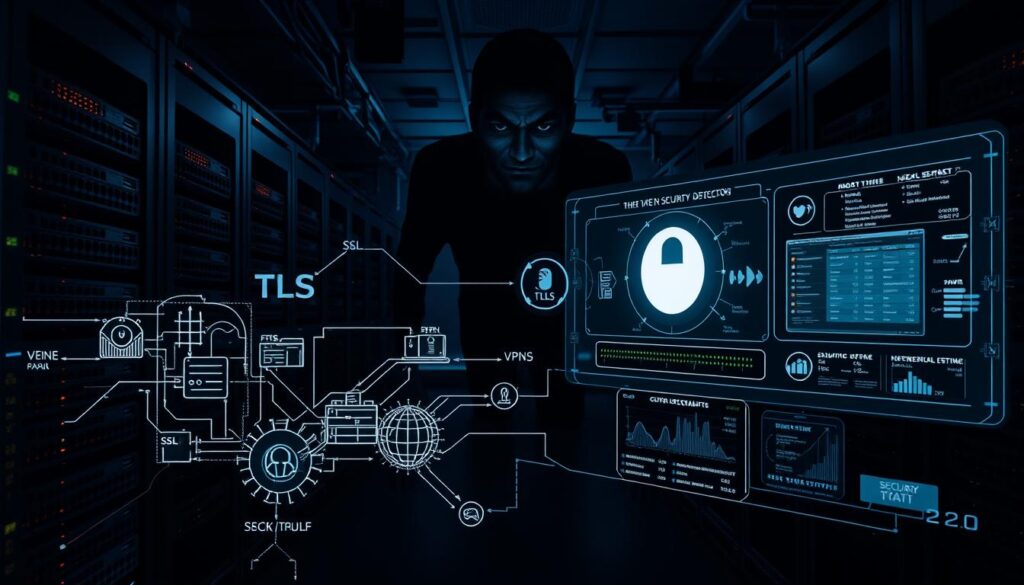
Stop Ransomware Attacks: Effective Prevention Strategies
Ransomware attacks are on the rise, and it’s crucial for individuals and organizations to take proactive measures to protect themselves. Ransomware prevention is a critical aspect of cyber attack defense, as it can help prevent significant financial losses and damage to reputation. By understanding the risks and taking steps to prevent ransomware attacks, individuals and organizations can ensure their sensitive data remains safe.
Effective ransomware prevention strategies involve a combination of technology, policies, and user awareness. By implementing robust cyber attack defense measures, individuals and organizations can reduce the risk of a successful ransomware attack. This includes regularly updating software, using antivirus programs, and educating users on how to identify and avoid suspicious emails and links.
Introduction to Ransomware Prevention
Ransomware prevention is an essential aspect of overall cyber attack defense. By prioritizing ransomware prevention, individuals and organizations can protect their sensitive data and prevent significant financial losses. In this article, we will explore effective strategies for preventing ransomware attacks and discuss the importance of ransomware prevention in cyber attack defense.
Key Takeaways
- Implementing robust ransomware prevention measures is critical to protecting sensitive data
- Regular software updates and antivirus programs are essential for cyber attack defense
- User awareness and education are key to preventing successful ransomware attacks
- Ransomware prevention is an ongoing process that requires continuous monitoring and updates
- Effective cyber attack defense involves a combination of technology, policies, and user awareness
- Ransomware prevention can help prevent significant financial losses and damage to reputation
Understanding the Modern Ransomware Threat Landscape
Ransomware attacks have become a significant concern for individuals and organizations alike, with the number of incidents increasing exponentially over the past few years. A robust data security strategy is essential in preventing these types of attacks. To develop an effective strategy, it’s crucial to understand the different types of ransomware attacks and the current trends.
Some common types of ransomware attacks include crypto-ransomware, locker ransomware, and doxware. Crypto-ransomware encrypts files, making them inaccessible to the user, while locker ransomware locks the device or screen, demanding payment in exchange for the unlock code. Doxware, on the other hand, threatens to publish sensitive information online unless the ransom is paid. Implementing malware protection measures can help prevent these types of attacks.
To stay ahead of these threats, it’s essential to stay informed about the latest trends and statistics. Some key trends include the increasing use of phishing emails and exploited vulnerabilities to gain access to systems. By understanding these trends and implementing a robust data security strategy and malware protection measures, individuals and organizations can reduce the risk of a successful ransomware attack.
Essential Components of Ransomware Prevention
Ransomware prevention requires a multi-layered approach that includes essential components such as cybersecurity measures. Implementing these measures can help prevent ransomware attacks by protecting against various types of threats. Some key components of ransomware prevention include:
Implementing firewalls, intrusion detection systems, and antivirus software are crucial cybersecurity measures that can help prevent ransomware attacks. These measures can detect and block malicious traffic, identify potential threats, and prevent malware from infecting systems.
In addition to these technical measures, it’s also important to implement cybersecurity measures such as employee training and awareness programs. These programs can help educate employees on how to identify and avoid potential threats, such as phishing emails and suspicious attachments. By combining technical and non-technical cybersecurity measures, organizations can create a comprehensive ransomware prevention strategy that protects against various types of threats.
Some other essential components of ransomware prevention include:
- Regular software updates and patches
- Secure data backup and recovery procedures
- Network segmentation and access control
These components can help prevent ransomware attacks by reducing the risk of infection and minimizing the impact of an attack. By implementing thesecybersecurity measures, organizations can protect their systems and data from ransomware threats.
Building a Strong Security Infrastructure
To prevent ransomware attacks, it’s essential to have a robust security infrastructure in place. This includes implementing network security protocols that can help detect and prevent threats. A strong security infrastructure is the foundation of a robust defense strategy, and it’s crucial to get it right.
Implementing network security protocols is a critical step in building a strong security infrastructure. This involves dividing the network into smaller segments to reduce the attack surface, controlling who has access to the network and data, and implementing security software requirements such as antivirus software, firewalls, and intrusion detection systems.
Some key considerations for building a strong security infrastructure include:
- Implementing network segmentation strategies to reduce the attack surface
- Controlling access to the network and data through access control implementation
- Implementing security software requirements such as antivirus software, firewalls, and intrusion detection systems
By implementing these measures, organizations can significantly reduce the risk of ransomware attacks and protect their sensitive data. Network security protocols play a critical role in this process, and it’s essential to get them right to ensure the security and integrity of the organization’s data.
Employee Training and Security Awareness
Employee training and security awareness are crucial in preventing ransomware attacks. By implementing effective threat mitigation techniques, organizations can significantly reduce the risk of a successful attack. This includes training employees to recognize and report suspicious emails, as well as educating them on safe browsing habits and the importance of keeping software up-to-date.
Some key aspects of employee training and security awareness include:
- Regular security awareness training sessions
- Simulated phishing attacks to test employee vigilance
- Clear communication of security policies and procedures
By investing in employee training and security awareness, organizations can strengthen their defenses against ransomware attacks and improve their overall cybersecurity posture. This is a critical component of a comprehensive threat mitigation techniques strategy, and can help protect against the devastating consequences of a ransomware attack.
Data Backup and Recovery Solutions
Implementing a robust data security strategy is crucial for ransomware prevention. One essential component of this strategy is data backup and recovery solutions. By having a reliable backup system in place, organizations can ensure that their critical data is protected and can be quickly recovered in the event of a ransomware attack.
Cloud Backup Strategies
Cloud backup strategies offer a convenient and scalable solution for data backup and recovery. This approach allows organizations to store their data in a secure, off-site location, making it easier to recover data in the event of a ransomware attack. Some benefits of cloud backup strategies include:
- Automatic backup and recovery
- Scalable storage capacity
- Secure data encryption
Offline Backup Methods
Offline backup methods, such as external hard drives or tape backups, provide an additional layer of protection against ransomware attacks. These methods allow organizations to store their data in a physical location, making it more difficult for attackers to access and encrypt the data.
Testing Recovery Procedures
Testing recovery procedures is critical to ensuring that data backup and recovery solutions are effective. Organizations should regularly test their backup and recovery systems to ensure that they can quickly and easily recover their data in the event of a ransomware attack. This includes testing the integrity of the backups, the speed of recovery, and the overall effectiveness of the recovery process. By implementing a robust data backup and recovery solution, organizations can strengthen their ransomware prevention and data security strategy.
Implementing Advanced Ransomware Prevention Techniques
To effectively prevent ransomware attacks, it’s essential to implement advanced prevention techniques. This includes enhancing cyber attack defense and im.xhtml malware protection measures. By doing so, organizations can significantly reduce the risk of a successful ransomware attack.
Some of the key techniques to consider include:
- Email security protocols to control access to email accounts and data
- Endpoint protection measures to control access to endpoints such as laptops and mobile devices
- Zero trust architecture to verify the identity of users and devices before granting access to the network and data
By implementing these advanced techniques, organizations can strengthen their cyber attack defense and malware protection measures, reducing the risk of a ransomware attack. This, in turn, can help protect sensitive data and prevent financial losses.

It’s essential to note that cyber attack defense and malware protection are ongoing processes that require continuous monitoring and updates. By staying informed and adapting to the latest threats, organizations can stay one step ahead of ransomware attackers and protect their sensitive data.
Incident Response Planning
Having a solid incident response plan in place is crucial for responding to ransomware attacks. This plan should include cybersecurity measures such as identifying the attack, containing the damage, and restoring systems. A well-planned response can help minimize the impact of a ransomware attack and reduce downtime.
Some key components of an incident response plan include:
- Identifying the type of attack and its scope
- Notifying stakeholders and authorities
- Containing the attack to prevent further damage
- Restoring systems and data from backups
- Conducting a post-incident review to identify areas for improvement
Implementing cybersecurity measures such as incident response planning can help organizations respond effectively to ransomware attacks. By having a plan in place, organizations can reduce the risk of data loss and minimize the impact of an attack.
Compliance and Regulatory Considerations
When it comes to preventing ransomware attacks, compliance and regulatory considerations play a crucial role. By implementing robust network security protocols and threat mitigation techniques, organizations can significantly reduce the risk of an attack. It is essential to understand the industry-specific requirements and regulations that govern data security and protection.
Some key considerations include data backup and recovery procedures, incident response planning, and employee training and awareness programs. By having these measures in place, organizations can ensure that they are well-equipped to prevent and respond to ransomware attacks. Effective network security protocols and threat mitigation techniques can help prevent attacks and minimize their impact.
Here are some key considerations for compliance and regulatory requirements:
- Industry-specific regulations and standards
- Data protection and privacy laws
- Incident response and notification requirements

By understanding and adhering to these requirements, organizations can ensure that they are in compliance with relevant laws and regulations, and that they are taking proactive steps to prevent ransomware attacks. Effective threat mitigation techniques and network security protocols are essential for protecting against ransomware attacks and minimizing their impact.
It is also important to regularly review and update compliance and regulatory considerations to ensure that they are aligned with changing regulatory requirements and emerging threats. By taking a proactive and comprehensive approach to compliance and regulatory considerations, organizations can help protect themselves against ransomware attacks and minimize the risk of data breaches and other security incidents.
Conclusion: Strengthening Your Ransomware Defense Strategy
In conclusion, preventing ransomware attacks requires a comprehensive approach that combines ransomware prevention and effective cyber attack defense strategies. By implementing the multifaceted solutions discussed throughout this article, individuals and organizations can significantly enhance their resilience against the ever-evolving ransomware threat.
Key to this defense is maintaining vigilant network security, empowering employees through security awareness training, and establishing robust data backup and recovery protocols. Additionally, staying up-to-date with the latest ransomware trends and industry-specific compliance requirements can help organizations proactively mitigate risks and protect their critical assets.
Remember, a strong ransomware defense strategy is an ongoing process that requires continuous monitoring, adaptation, and improvement. By remaining diligent and employing a layered security approach, you can significantly reduce the chances of falling victim to devastating ransomware attacks and safeguard your digital ecosystem.
FAQ
What is ransomware and how does it work?
Ransomware is a type of malware that encrypts a victim’s files and demands a ransom payment in exchange for the decryption key. Attackers use various methods to infect systems, such as phishing emails, software vulnerabilities, and remote access tools. Once installed, the ransomware encrypts files, making them inaccessible until the ransom is paid.
What are the common types of ransomware attacks?
The most common types of ransomware attacks include crypto-ransomware, which encrypts files, locker ransomware, which locks users out of their devices, and doxware, which threatens to publicly release sensitive data if the ransom is not paid.
What are the essential components of ransomware prevention?
Effective ransomware prevention requires a multi-layered approach, including cybersecurity measures such as firewalls, antivirus software, and intrusion detection systems, as well as employee training and security awareness programs to help identify and avoid potential threats.
How can I build a strong security infrastructure to prevent ransomware attacks?
Building a strong security infrastructure involves strategies like network segmentation, access control implementation, and deploying the right security software. This helps reduce the attack surface and limits the spread of any potential ransomware infection.
Why is employee training and security awareness important for ransomware prevention?
Employees are often the weakest link in an organization’s security chain, as they can inadvertently fall victim to phishing scams or other social engineering tactics used by ransomware attackers. Comprehensive employee training and security awareness programs can help mitigate this risk.
What data backup and recovery solutions are effective in preventing ransomware attacks?
Implementing robust data backup and recovery solutions, such as cloud-based backups and offline backup methods, can help organizations recover from a ransomware attack without having to pay the ransom. Regular testing of recovery procedures is also crucial.
What advanced ransomware prevention techniques can I implement?
Advanced ransomware prevention techniques include implementing email security protocols, endpoint protection measures, and adopting a zero-trust architecture. These strategies help further strengthen an organization’s cybersecurity defenses against ransomware attacks.
How important is incident response planning in ransomware prevention?
Incident response planning is critical in the event of a ransomware attack. Having a well-defined plan in place can help organizations quickly contain the damage, restore operations, and minimize the impact of a ransomware incident.
What compliance and regulatory considerations are important for ransomware prevention?
Compliance with industry-specific requirements, documentation and reporting protocols, and understanding legal obligations during a ransomware attack are all essential considerations for organizations. Adhering to these guidelines can help strengthen an organization’s ransomware defense strategy.